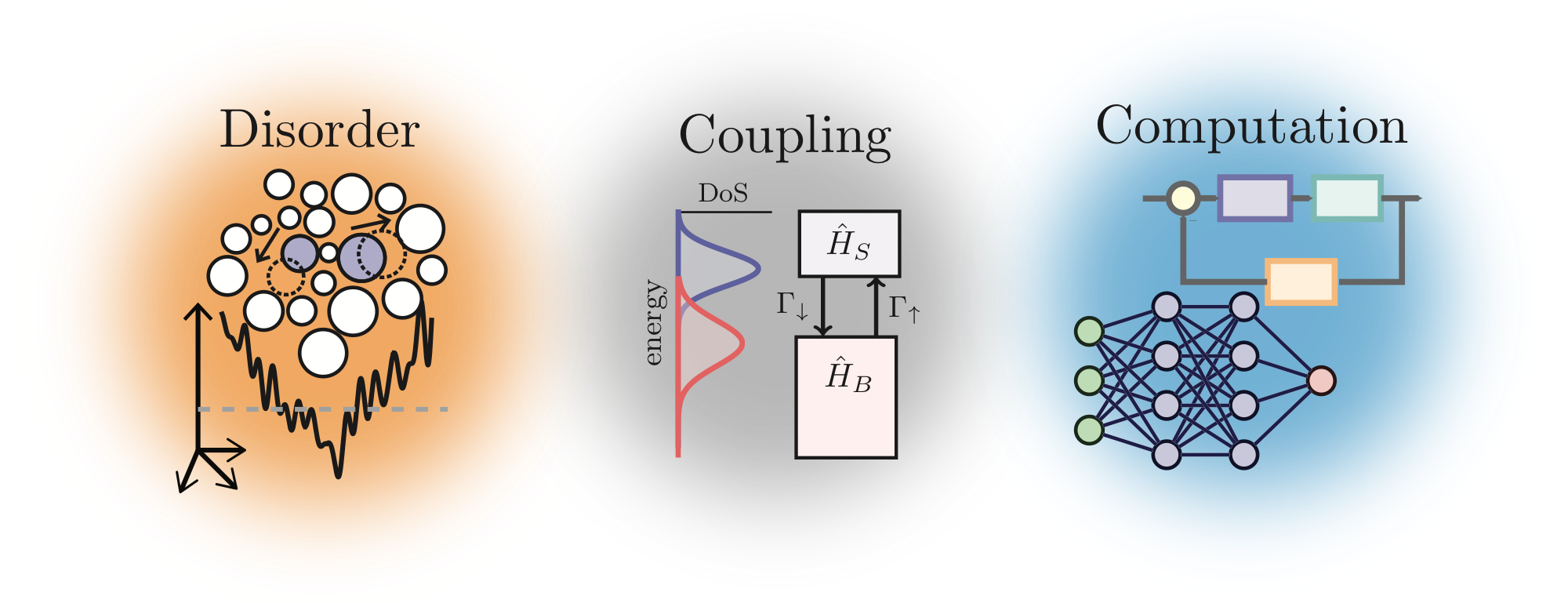Faculty Statement
Research Vision
Control and Emergence of Nonequilibrium Materials: Disorder, Coupling, and Computation Across Scales
Functional materials rarely operate at equilibrium. Structural glasses age over decades; colloidal suspensions jam and unjam under shear; active matter converts chemical energy into motion; and molecular junctions sustain steady electronic currents. These systems involve common transport phenomena—relaxation, flow, dissipation, and mass transfer—but all face the same challenge: the equilibrium thermodynamic principles for harnessing them no longer hold. In my view, these are not isolated puzzles but manifestations of a single question that defines modern materials and chemical engineering: How do transport of energy and information shape and stabilize materials out of equilibrium?

I aim to study and control nonequilibrium materials, ranging from soft matter to advanced materials, through the unifying ideas of Disorder, Coupling, and Computation:
- Disorder defines the challenge through rugged energy landscapes that trap materials in metastable states
- Coupling provides control via interactive environments—optical cavities, electrodes, and mechanical actuators—that channel energy and mass transfer
- Computation defines the methodology through multiscale process modeling including finite-element methods, molecular dynamics simulations, electronic-structure theory, machine learning, and process control theory
This research program is structured around three thrusts:
- Thrust 1: Transport and Hydrodynamic Control of Colloidal Gels: developing predictive models for kinetic arrest and tunable rheology through integrated theory, simulation, and feedback control
- Thrust 2: Photonic Engineering of Supercooled Liquids: engineering light-matter coupling to reshape relaxation pathways and discover new disordered phases of matter inaccessible under equilibrium
- Thrust 3: Foundational Models for Electrochemically Driven MD: building datasets and ML models for MD under electrical currents with applications to electrochemical reactors and catalyst design
Teaching Philosophy and Course Contributions
My teaching rests on empathetic rigor: understanding who my students are and what they need to succeed in order to instill rigor and precision in their training. In the age of AI, empathetic rigor means meeting students where they already use tools like ChatGPT and then channeling that use into disciplined habits of verification and reflection. My teaching methods include transparent, AI-aware process documentation where students document their use of AI tools, periodic in-class “AI audits” to identify and correct model-generated errors together, and deeper, biweekly assignments that allow exploration while preserving judgment through units, limits, baselines, and reproducibility checks. The goal is to turn AI from a shortcut into an object of analysis, helping students graduate with the ability to defend results they trust.
Teaching Experience: I have previously taught classical and statistical thermodynamics at UC Berkeley, providing me with hands-on experience in delivering rigorous thermodynamics and physical chemistry education at the undergraduate level.
Course Readiness: I am ready to serve and teach courses that build upon chemical engineering thermodynamics and transport phenomena, as well as more general chemistry courses and physical chemistry. I am also prepared to teach physics-based courses on statistical mechanics. My background spans core chemistry curriculum including general chemistry, physical chemistry, undergraduate thermodynamics, as well as graduate courses in statistical mechanics and computational methods.
Specialized Courses: Based on my expertise, I can also teach specialized courses:
- Special Topics in Statistical Dynamics: Transport from microscopic descriptions of fluids using Irving–Kirkwood coarse-graining, Green–Kubo formulas, molecular dynamics, mode-coupling theory, and rare events including transition-state theory and string methods
- Asymptotics, Numerics, and Statistics: Methods course covering asymptotic analysis for differential equations, numerical methods for ODE/PDE with convergence verification, and probabilistic thinking from linear regression to machine learning for chemical modeling
All courses incorporate transparent AI attribution and verification practices, equipping Chemistry students to apply contemporary tools with care while maintaining rigorous scientific reasoning.